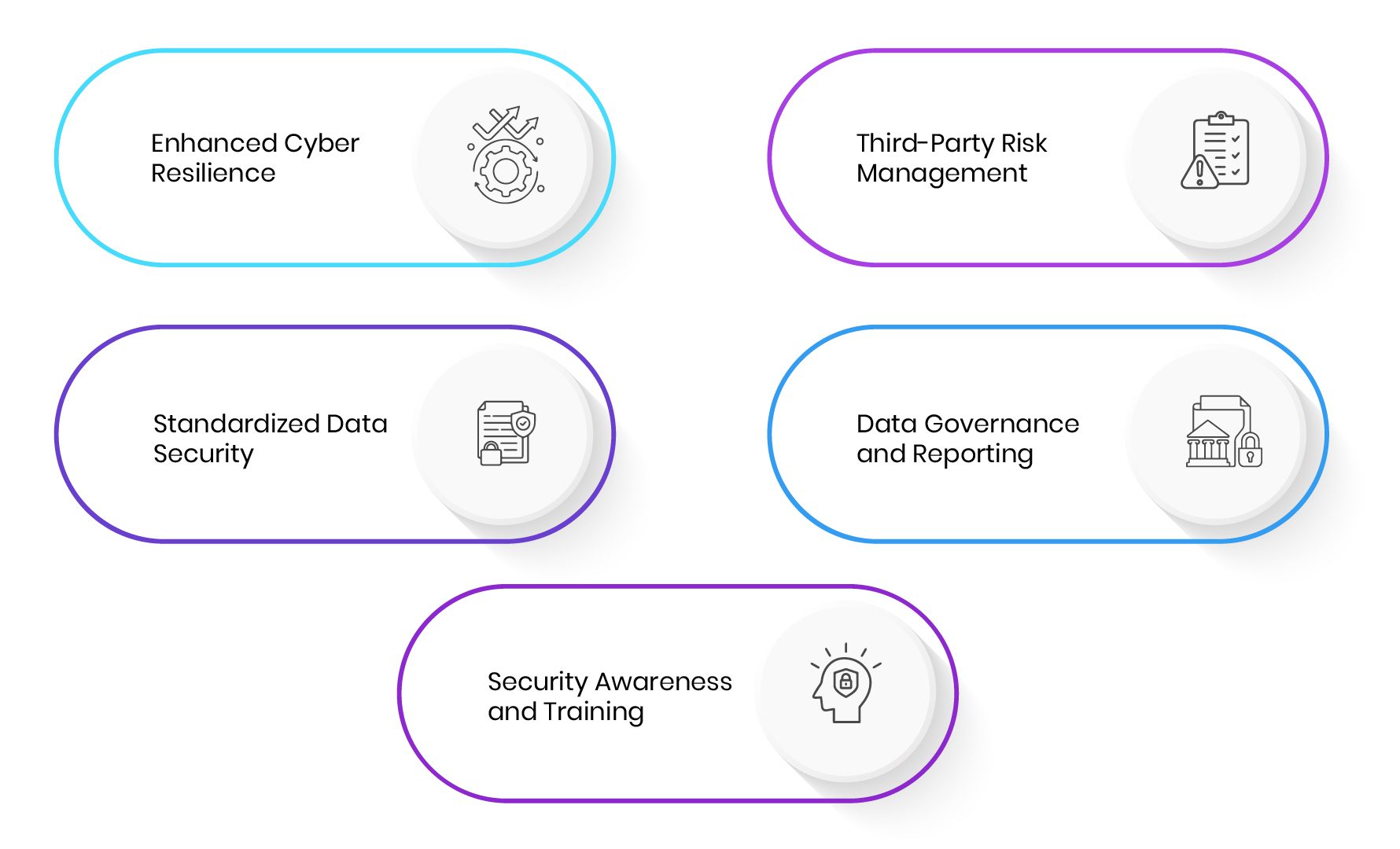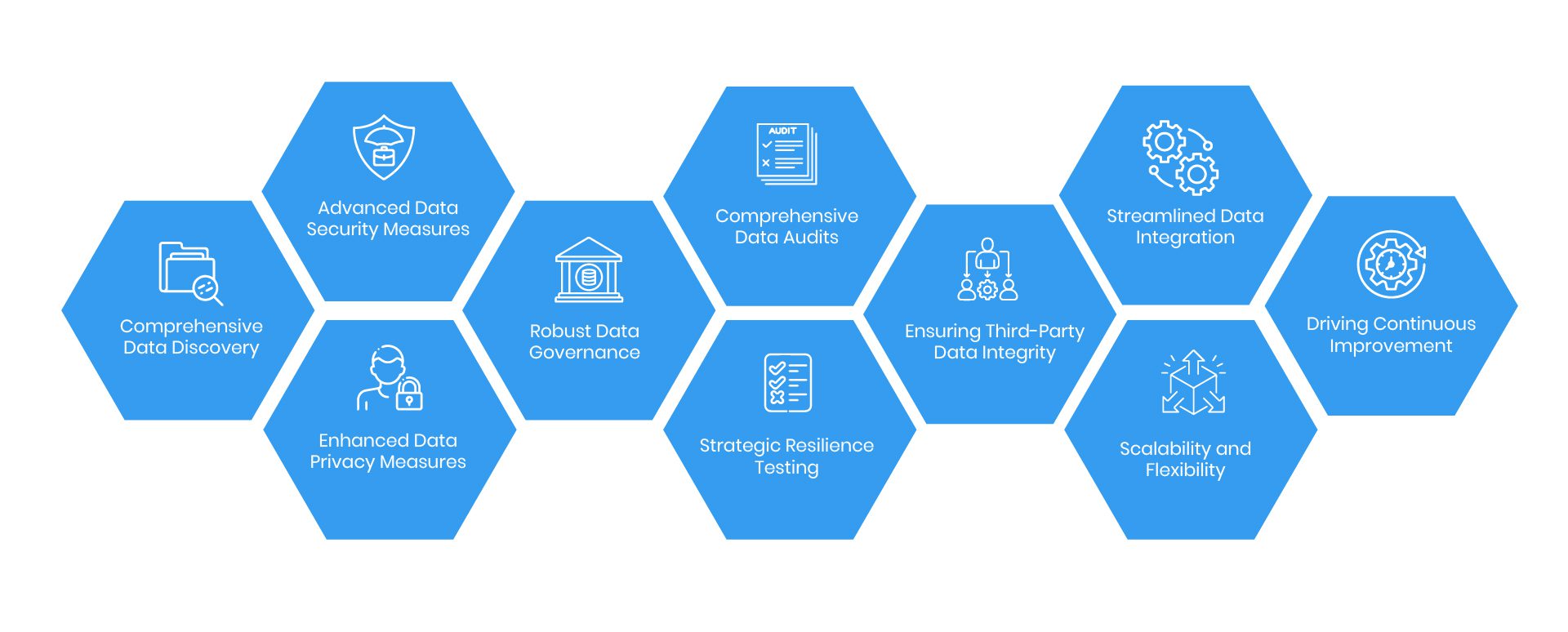- Introduced in November 2022, the Digital Operational Resilience Act (DORA) integrates ICT specifications into operational resilience regulations for EU financial institutions.
- Stemming from the financial sector’s increased reliance on digital technology post-pandemic, DORA aims to enhance digitalization within financial services while fortifying operational resilience.
- Given these rigorous requirements, financial institutions must prioritize effective data management practices aligned with DORA guidelines. This entails implementing stringent data handling and security measures and fostering strong partnerships with third-party service providers to mitigate risks effectively.
- Unified Data Management (UDM) solutions emerge as a strategic imperative in this endeavor. They offer a comprehensive framework for centralized governance, advanced security measures, and data lifecycle management, thereby fostering a robust data ecosystem aligned with DORA guidelines.
What is DORA?
In the fast-paced world of finance, adaptability is a necessity. That’s where the Digital Operational Resilience Act (DORA) steps in. Introduced by the European Union in November 2022, DORA isn’t merely a set of rules; it’s a lifeline for financial institutions navigating the turbulent times of cyber threats and operational disruptions. Fast forward to January 17, 2025, and every financial entity within the EU, along with those serving EU-based firms, must comply with DORA’s exacting standards. But this isn’t just about regulatory compliance; it’s about fortifying the integrity of financial systems and preserving trust in the global economy.
So, what does DORA entail? DORA stands as the most recent component of the EU Digital Finance Package (DFP).
The necessity arises from the heightened reliance of the financial sector on digitized information technology and data, particularly accentuated in the post-pandemic era. It is crafted to encourage the increased digitization of services within the financial industry while reinforcing and fortifying operational resilience. It’s more than just a checklist—it’s a holistic approach that integrates Information and Communications Technology (ICT) specifications into existing frameworks. A recent report by Accenture highlights that by 2025, global spending on digital transformation in banking is expected to reach $320 billion.
Enhanced cybersecurity measures? Check. Standardized data security protocols? Check. Third-party risk management? Robust data governance? Incident response plans? Check, check, and check. As the latest addition to a continuous series of regulatory measures from both the EU and the U.S., all aimed at enhancing organizations’ capacity to protect sensitive data and recover from business disruptions, DORA builds upon existing readiness standards rather than replacing them.
But why should financial institutions care? The answer is clear: survival. In an era where cyber threats loom large, and disruptions can be catastrophic, DORA compliance is a strategic imperative. By embracing DORA, institutions demonstrate their commitment to resilience and safeguarding their customers’ interests.
Enter Unified Data Management (UDM) solutions—the proven solution for data compliance. In a landscape where data is both the lifeblood and the Achilles’ heel of financial institutions, UDM solutions offer a lifeline. By consolidating disparate data sources, streamlining workflows, and fortifying defenses against cyber threats, UDM solutions serve as the cornerstone of DORA compliance.
In this blog, we delve into the core objectives of DORA and why it’s crucial for financial institutions. By scrutinizing the necessity of aligning with DORA’s requirements, the article emphasizes the pivotal role of Unified Data Management (UDM) solutions as a tried-and-tested approach and shares ten ways it helps enterprises navigate the complexities of financial data management and achieve compliance with DORA. Keep reading to discover more.
Importance of DORA in the Finance Sector
For banks, the process of complying with DORA presents an opportune moment to reassess their existing security policies and procedures. Commencing this review sooner rather than later is imperative—while 2025 might seem distant, the identification of issues, implementation of solutions, and the assessment of their impact can be a time-consuming endeavor.
DORA’s implications extend beyond the confines of banks. Specifically, the regulations draw attention to third-party entities offering information communication technology services to banks, including cloud platforms, data analytics services, and solutions from various IT partners and providers. Consequently, banks are not only tasked with ensuring their own compliance but are also obligated to verify that any service provider handling digital financial data adheres to DORA regulations.

Enhanced Cyber Resilience: The mandates compel financial institutions to fortify their cyber resilience through comprehensive risk management, incident response, and resilience testing. The focus is on safeguarding sensitive financial data from unauthorized access or manipulation, which is crucial in an era heavily reliant on digital systems.
Standardized Data Security: Harmonizing regulations across EU member states establishes a unified approach to data security. This simplifies compliance for institutions operating across jurisdictions, fostering streamlined data sharing within the regulatory framework.
Third-Party Risk Management: Recognizing the interconnectedness of the financial ecosystem, the mandates require third-party service providers to adhere to similar data security and resilience standards. This aims to mitigate vulnerabilities that could have cascading effects on financial institutions in the event of breaches.
Data Governance and Reporting: Data governance is an important core element of risk management. Financial institutions must implement robust frameworks to identify, classify, and secure sensitive data, and incident reporting requirements emphasize the need for efficient data management practices.
Security Awareness and Training: The mandates make security awareness training mandatory for employees, empowering them to play an active role in data protection and cybersecurity. This proactive approach contributes to a strengthened data security posture.
One common word that you might have noticed in all the above points is DATA… and boy, it’s growing. Industry experts like Gartner predict zettabyte-scale data volumes for financial institutions by 2025. That’s a trillion terabytes, or enough to store every movie ever made 100,000 times! Given these statistics, it’s a no-brainer that in ensuring DORA compliance, data takes center stage, evolving from its traditional role as mere storage into a dynamic asset. No longer confined to passive storage, it emerges as a strategic powerhouse driving innovation and ensuring regulatory adherence. And with unstructured data projected to dominate 80% of all data by 2025, as forecasted by Gartner, the need to harness its potential has never been more urgent.
However, grappling with unstructured data presents a host of challenges. The sheer volume and varied formats of data sources pose formidable obstacles to compliance efforts. McKinsey warns that while tapping into insights from unstructured data can offer competitive advantages, many organizations struggle to extract meaningful insights due to their complexity.
The importance of effective data management in achieving DORA compliance cannot be overstated. Financial institutions must cultivate robust data governance frameworks to ensure data integrity, privacy, and security. This entails not only establishing clear policies and procedures but also implementing mechanisms for continuous monitoring and enforcement. Moreover, advanced data analytics emerges as a linchpin in the compliance arsenal. By leveraging analytical tools and techniques, institutions can glean actionable insights from unstructured data, thereby enhancing risk detection and regulatory adherence. For instance, predictive analytics can help anticipate potential threats, while sentiment analysis can provide valuable insights into customer behavior and market trends.
Also, it’s important to note compliance isn’t just about meeting regulatory requirements—it’s about achieving operational excellence. According to Deloitte, organizations embracing data-driven decision-making are three times more likely to achieve significant improvements in efficiency and risk management. Data isn’t just a tool; it’s the driving force behind growth and resilience.
In conclusion, to effectively manage the complexities of unstructured data and achieve seamless compliance with DORA, financial institutions require robust solutions. Unified Data Management (UDM) emerges as a comprehensive solution, offering a holistic approach to data governance, integration, and analytics. By centralizing data management processes and providing actionable insights, UDM empowers organizations to optimize compliance efforts, mitigate risks, and drive sustainable growth in the ever-evolving regulatory landscape. Let’s find out how.
Empowering Data Excellence: 10 Ways UDM Elevates DORA Compliance

Comprehensive Data Discovery: UDM software and solutions deliver data discovery capabilities that extend beyond traditional methods, utilizing advanced algorithms and machine learning to uncover hidden insights within vast datasets. By analyzing not just the data itself but also its context and relationships, UDM enables organizations to unearth valuable information that may have otherwise remained undiscovered. This approach empowers financial institutions to make informed decisions based on a holistic understanding of their data landscape, driving innovation and competitive advantage.
Advanced Data Security Measures: In today’s ever-evolving threat landscape, conventional data security measures simply won’t cut it. UDM software leverages cutting-edge encryption algorithms and AI-powered anomaly detection to safeguard against emerging cyber threats. By continuously monitoring data access patterns and proactively identifying potential vulnerabilities, UDM enables organizations to stay one step ahead of attackers and maintain the integrity of their sensitive information. This proactive stance not only enhances regulatory compliance but also instills confidence among customers and stakeholders, reinforcing the organization’s reputation as a trusted custodian of data.
Enhanced Data Privacy Measures: UDM’s approach to data privacy focuses on building trust and transparency with customers and stakeholders. UDM solutions enable organizations to protect sensitive information while preserving data utility and usability by implementing privacy-enhancing technologies such as differential privacy and homomorphic encryption. This customer-centric approach not only enhances regulatory compliance but also strengthens the organization’s reputation as a trusted steward of data privacy.
Robust Data Governance: Transparency, accountability, and integrity are the cornerstones of effective data governance—and UDM delivers them in spades. Its implementation of blockchain technology revolutionizes data governance by introducing unprecedented levels of transparency and immutability. Through blockchain-based audit trails and smart contracts, UDM solutions ensure that data governance policies are enforced consistently across the organization, minimizing the risk of errors and disputes. This decentralized approach fosters trust among stakeholders and regulatory authorities, positioning the organization as a pioneer in transparent and accountable data management practices.
Comprehensive Data Audits: Compliance shouldn’t be a box-ticking exercise—it should be an opportunity for growth, focusing on uncovering actionable insights and driving continuous improvement. By leveraging advanced analytics and machine learning algorithms, UDM software identifies patterns and trends within audit data, enabling organizations to address emerging risks and opportunities proactively. This proactive stance not only enhances regulatory compliance but also drives operational excellence, positioning the organization as a leader in data-driven decision-making.
Strategic Resilience Testing: In today’s volatile world, resilience is imperative for business. We need resilience testing protocols that are designed to simulate real-world scenarios with unprecedented accuracy and granularity. And that’s exactly what UDM software promises. By incorporating elements of gamification and scenario planning, UDM transforms resilience testing from a routine exercise into a strategic opportunity for innovation and learning. This forward-thinking approach not only enhances the organization’s ability to withstand cyber threats and operational disruptions but also fosters a culture of resilience and adaptability across the organization.
Ensuring Third-Party Data Integrity: UDM’s approach to third-party data management goes beyond vendor assessments, focusing on building collaborative partnerships based on trust and transparency. By implementing blockchain-based data-sharing protocols and secure APIs, UDM enables seamless integration and data exchange with third-party providers while maintaining data integrity and confidentiality. This collaborative approach not only enhances regulatory compliance but also drives innovation and agility in the organization’s data ecosystem.
Streamlined Data Integration: In a world of data silos and disparate systems, integration is key to unlocking the full potential of your data. And this can only be done by creating a unified data ecosystem that drives innovation and collaboration. By implementing open standards and APIs, UDM solutions enable seamless integration and data exchange across disparate systems and platforms, unlocking new opportunities for insight and discovery. This forward-thinking approach not only enhances operational efficiency but also fosters a culture of innovation and agility across the organization.
Scalability and Flexibility: UDM solutions are designed keeping in mind enterprise data ecosystems that are dynamic and can easily adapt and evolve in response to changing business needs and regulatory requirements. By leveraging cloud-native technologies and microservices architecture, UDM solutions enable organizations to scale their data infrastructure rapidly and cost-effectively while maintaining regulatory compliance and operational resilience. This forward-thinking approach not only enhances agility and innovation but also future-proofs the organization’s data ecosystem against emerging challenges and opportunities.
Driving Continuous Improvement: Compliance shouldn’t be a one-time event—it should be a journey of continuous improvement and innovation. By leveraging advanced analytics and machine learning algorithms, UDM solutions enable organizations to uncover hidden patterns and insights within their data, driving strategic decision-making and competitive advantage. This forward-thinking approach not only enhances regulatory compliance but also positions the organization as a leader in data-driven innovation and excellence.
Unified Data Management (UDM) has evolved from more than just a want — it’s a strategic imperative for financial institutions seeking to thrive in the digital era. By harnessing the power of advanced analytics, machine learning, and blockchain technology, UDM solutions empower organizations to achieve compliance with the Digital Operational Resilience Act (DORA) while driving innovation, growth, and operational excellence.
With UDM, you can unlock the full potential of your data, safeguard your sensitive information, and build trust with stakeholders and customers alike. So why settle for conventional data management solutions when you can embrace the future with UDM? It’s time to elevate your data management practices, secure your compliance, and unlock new opportunities for success.
The Data Dynamics Advantage
In today’s fast-paced world of financial data management, ensuring compliance with regulations like the Digital Operational Resilience Act (DORA) isn’t just a matter of ticking boxes—it’s about navigating a complex landscape with precision and foresight. That’s where Data Dynamics steps in, offering not just a solution but a strategic partnership to help financial institutions thrive in the digital age.
At the heart of Data Dynamics’ offering is its Unified Unstructured Data Management Software —a powerful tool built on cutting-edge technologies like automation, artificial intelligence (AI), machine learning (ML), and blockchain. Trusted by over 28 Fortune 100 organizations, —it’s a comprehensive software designed to scale seamlessly and ensure unwavering compliance with DORA guidelines across diverse enterprise workloads.
What sets Data Dynamics apart is its commitment to going beyond the surface level. With its Content Analytics module, powered by a blend of advanced technologies, organizations gain deep insights into the intricacies of their data. This isn’t just about identifying files—it’s about understanding the nuances of sensitivity, consumer insights, and business value buried within the data.
Coupled with the Risk Exposure Insights feature, which provides actionable insights to guide decision-making, Data Dynamics empowers organizations to navigate the data landscape with confidence and clarity. From proactive risk remediation to stringent access controls, Data Dynamics ensures that sensitive data is protected at every step. With the Open Share Reporting functionality, organizations can rest assured that their data remains secure, even in open shares, aligning seamlessly with regulatory frameworks governing the finance sector.
But Data Dynamics isn’t just about compliance—it’s about laying the groundwork for a future where data is democratized. Imagine a world where users of all technical backgrounds can seamlessly access and interpret data, driving innovation and growth. This isn’t just a vision—it’s a reality that Data Dynamics is helping to bring to life, turning data from a siloed resource into a democratized asset accessible to all stakeholders.
In a landscape where effective data management is crucial, Data Dynamics emerges as the trusted partner for financial institutions. More than just a vendor, Data Dynamics is a strategic ally committed to empowering organizations to thrive in the digital age. It’s about more than compliance—it’s about shaping the future of data management and unlocking new possibilities for growth and innovation.
Discover how Data Dynamics can be your trusted ally in navigating the complexities of financial data management and achieving compliance with DORA today and tomorrow.
Explore Data Dynamics’ offerings at www.datadynamicsinc.com or reach out to us at solutions@datdyn.com or (713) 491-4298.






